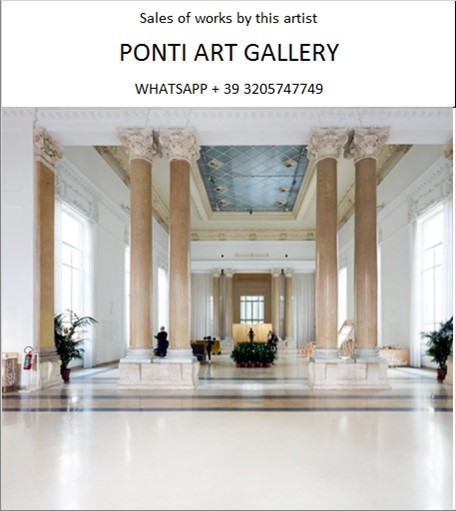Ponti Art Gallery is interested in buying and selling works
of art by this artist.

Atsuko Tanaka Biography
Atsuko Tanaka was a pioneering Japanese avant-garde artist, born on February 10, 1932, in Osaka, Japan. She emerged as a central figure in the post-war Japanese art scene, significantly contributing to the avant-garde movement through her innovative works that spanned painting, sculpture, performance, and installation art. Tanaka's artistic journey began in earnest when she enrolled at the Art Institute of Osaka Municipal Museum of Art in 1950, where she met fellow artists who would play crucial roles in her development, including her future husband, Akira Kanayama. By the second year at the institute, she had moved away from her previous figurative style, exploring new artistic languages and expressions.
Tanaka's early artistic explorations were influenced by her hospitalization in 1953-1954, during which she began creating non-figurative artworks inspired by a calendar, leading to a series of works that consisted of handwritten numbers on various collaged materials. This period marked the beginning of her departure from traditional art forms and her venture into abstract expressions. In 1955, Tanaka, along with Kanayama and other members of the Zero Society, joined the Gutai Art Association, an avant-garde artists' group led by Yoshihara Jiro. Gutai's ethos of breaking away from traditional art to embrace innovation and experimentation resonated with Tanaka, propelling her to create some of her most iconic works.
Among her most celebrated contributions to the Gutai movement was the "Electric Dress" (1956), a wearable sculpture made of hundreds of colored light bulbs and electrical cables. This piece not only demonstrated Tanaka's fascination with technology and its intersection with the body but also reflected the rapid modernization of post-war Japan. The "Electric Dress" became a symbol of the Gutai movement's embrace of new materials and technologies, as well as a statement on the merging of art and life. Tanaka's performances, often involving experimental clothing, conceived of her body as a malleable painting, creating shifting formal compositions of color and light.
Tanaka's work extended beyond performance art to include abstract painting, where she continued to explore themes of connectivity and technology. Her paintings, characterized by vibrant colors connected by dripped and drawn lines, suggest electronic circuitry and retain a record of her movements across the canvas. These works are seen as an expansion of her earlier performances and installations, reflecting the ethos of Gutai in their embrace of unconventional materials and methods.
After leaving the Gutai group in 1965, Tanaka continued to evolve her artistic practice, focusing more on painting while still incorporating the themes of technology and innovation that had defined her earlier work. Her later paintings became more expressive and complex, featuring an array of bright colors and intricate patterns that evoked the nervous system or electronic circuits. Despite the shift in medium, Tanaka's work remained deeply connected to her earlier explorations of the relationship between art, technology, and the body.
Tanaka's contributions to the art world have been recognized in numerous solo and group exhibitions both in Japan and internationally. Her work has been featured in major exhibitions such as "Electrifying Art: Atsuko Tanaka 1954-1968" at the Grey Art Gallery in New York and "Gutai: Splendid Playground" at the Solomon R. Guggenheim Museum in New York. Her legacy continues to influence contemporary artists and remains a vital part of the discourse on post-war Japanese art and the avant-garde movement.
Atsuko Tanaka passed away on December 3, 2005, in Nara, Japan, leaving behind a body of work that continues to inspire and challenge the boundaries of art. Her innovative approach to materials, her exploration of the intersection between technology and the human body, and her contributions to the Gutai movement have cemented her place as one of the most important avant-garde artists of the 20th century.
Atsuko Tanaka Quotes and Sales
of Works
Ponti Art Gallery selects and deals with paintings by the
artist. Upon request, we provide free estimates and
evaluations, communicate prices, quotations, and current
market values.
If you are interested in BUYING or SELLING works by the
artist, contact us immediately.
If you wish to sell or receive an evaluation of the
works:
Send us a frontal photo of the painting, one of the back,
and one of the signature. Also, indicate the dimensions of
the work. Inform us about the purchase origin of the work
and any kind of available documentation (purchase
receipts, certificates of authenticity, publications). One
of our operators will respond to you on the same day. We
guarantee maximum confidentiality and extreme
professionalism.
If you wish to purchase works by the painter: Contact us
and let us know your request. We will inform you about the
available works. We also offer the possibility to
subscribe to our NEWSLETTER, through which you will be
informed at the beginning of each month about the latest
acquisitions of the art gallery.
You can send us pictures of the work:
